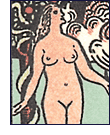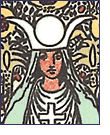|

The Tarot cards by their character form a cyclical,
matriarchal and nature based religious concept. This somewhat defies
the belief of Christian doctrine and as was the case during the
middle ages was subject to suppression alongside a number of other
alternative beliefs. This conflict with Christianity cemented itself
among the persecuted who could hide their true feelings in the visual
imagery of the cards. The cards were then appreciated on many levels
not only by those gypsies and philosophers who sought to read the
future and gain enlightenment but also as a ‘Bible of Bibles’
whereby the reader could interpret and instruct according to his
or her needs, desires or wants. The freedom of thought which embraced
the persecuted struck home for obvious reasons and fueled the already
strong belief that tarot cards contained mystical qualities revealing
the truths oppressive religions attempted to keep hidden.
 Female
symbolism pervades throughout the tarot deck and the female form
consistently emerges as that which guides and enlightens whenever
encountered in the pack. It is this symbolism which bonds many other
religious beliefs with that of the Tarot deck. Gypsies and Celts
refer to the mother center of earth as Tara, Semites knew this figure
as Terah and Romans refer to her as Terra Mater. Buddhists see the
lotus as a symbol for the hub of human life and openly attribute
the source of all universal life to the female. The connection with
the word ‘Tarot’ may be nothing more than a coincidence
as the origins of this word is not clear. It is apparent though
that there are a number of essential beliefs that intertwine themselves
with Tarot philosophy and that of other commonly practiced faiths. Female
symbolism pervades throughout the tarot deck and the female form
consistently emerges as that which guides and enlightens whenever
encountered in the pack. It is this symbolism which bonds many other
religious beliefs with that of the Tarot deck. Gypsies and Celts
refer to the mother center of earth as Tara, Semites knew this figure
as Terah and Romans refer to her as Terra Mater. Buddhists see the
lotus as a symbol for the hub of human life and openly attribute
the source of all universal life to the female. The connection with
the word ‘Tarot’ may be nothing more than a coincidence
as the origins of this word is not clear. It is apparent though
that there are a number of essential beliefs that intertwine themselves
with Tarot philosophy and that of other commonly practiced faiths.
Gypsy philosophy and religious belief centres on the cyclical nature
of life. The world will forever be in flux and evolving but the
cycle of life continues unabated and the end will inevitably meet
up with the beginning in time. Life, death and reincarnation are
intrinsic elements of the Tarot deck and one cannot necessarily
read each card through its literal imagery. It is the interpretation,
which is the essential component of a tarot reading.
In a similar manner Hindus believe the Goddess Kali governs creation
and it is she who gave birth to time and the methods of measuring
it. As the seasons operate on a cyclical basis so too the wheel
of time, forever turning yet remaining constant that forms the cornerstone
of the tarot deck. It gave comfort to so many, who with no religious
order to follow, took up the self interpreting nature of the tarot
deck as their chosen path.
 In
Europe illiteracy was extremely high even in the latter part of
the nineteenth century. Amongst others it was this factor which
led to the increase in the religious and holy following of the Tarot
cards. Sacred and prophetic powers were thought to emanate from
the cards as during this period it was very uncommon to own a bible
and even more so to be able to read it. Before the time of the reformation
the bible was written in Latin which further segregated the common
man from the accessibility of religion. In
Europe illiteracy was extremely high even in the latter part of
the nineteenth century. Amongst others it was this factor which
led to the increase in the religious and holy following of the Tarot
cards. Sacred and prophetic powers were thought to emanate from
the cards as during this period it was very uncommon to own a bible
and even more so to be able to read it. Before the time of the reformation
the bible was written in Latin which further segregated the common
man from the accessibility of religion.
As a result of the Tarot cards divine visual imagery a large following
emerged which further enhanced claims that it was sacred and holy.
There were alternative forms of scared material available such as
the Pagan scriptures and Cabalistic books. Underneath the surface
these too referred to mystical philosophy and teachings. Bibles
of the East were arranged in card like format. They were collated
and bound together with string to form a primitive bible of beliefs.
The western philosophy that eastern idols and images have mystical
qualities still pervades today and it is this amongst other ties
with religious thinking that continues to link Tarot cards with
religion and the occult.
|





